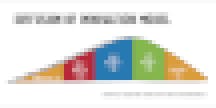In my heart, I will always be a middle school English Language Arts teacher. As I continue this path as a district administrator, I want to hold close to my heart the plight of the teacher: what it’s like to have to work all day with children and then go home and work on lessons, assessments, grading, etc. What it’s like to sit for hours in professional development sessions and be bored because you already know it or frustrated because it’s way over your head or not relevant to your grade level or content area.
So in my role, I find that it is imperative to provide Professional Learning (PL) opportunities that are relevant, on-going, and effective. In the article, I’m going to highlight the types of educators that we may encounter and ways to provide PL that is beneficial for all.
In a book titled " Crossing the Chasm" (1991, revised 1999 and 2014), Geoffrey A. Moore focuses on marketing strategies for technology start up companies, but I find the idea can also be applied to teachers integrating technology in the classroom.

The Lagger
“I don’t like technology. Technology doesn’t like me. It’s too much. Kids don’t need to play games, they need to learn.” These are the ones that you have to drag kicking and screaming to classroom technology integration. Everything was fine before, so why do they need to change?
The Solution: First and always - talk about the why. Talk to them about how everything we do is to prepare our students to be productive citizens in their society and how we do them a disservice by not providing them with access to tools that will assist our children in doing just that. Take things sloooooooowly. These teachers benefit from sessions that are either one-on-one or small group. Encourage baby steps and be realistic in expectations. Talk to them about things they can do to make things easier in their life in general. For example: talk to them about using a grading app to help them score multiple choice assessments, Google Drive for organizing and having constant access to files, or using a gamified formative assessment tool (Kahoot!, Quizizz, Socrative, Quizlet Live, etc.) that will allow them to gain immediate feedback to quickly differentiate students’ needs. In your conversation, have them choose one tool and allow them to develop that tool until they feel completely comfortable.

The Majority
“I see the merits in some technology. I use it when I can ‘fit it in’.” These teachers know how to handle the basics, but aren’t very comfortable going much further.
The Solution: Find a way to consistently share tools that are fairly easy to implement. Introduce them to a tool, have them use it with their students, reconvene to discuss the process and adjustments. When I was still a Teacher Leader, I initiated “Tech Tuesdays”. With my principal’s support, I met with our faculty once a month and introduced them tools that fell under a specific category. Throughout that month, teachers practiced with the tool and shared examples of student usage with the administrative staff and me. We ‘gamified’ this process, so that they could earn points and rewards for taking the leap - they absolutely loved it! For those teachers that were still a bit apprehensive, they scheduled 1-on-1 time with me to meet and flesh out their concerns and make tweaks.
Early Adopters
“I just saw Amy use this awesome tool in her classroom. I’m going to go home this weekend and figure out how to implement it with my students!” Your early adopters jump right on a tool or resource as soon as they see it being successful somewhere else. They are always looking for ways to provide better opportunities for their students with technology.
The Solution: Share, share share! You want the early adopters to be visible to other teachers so they can see tools working. Sometimes the adopters become so focused on tools that they don’t take time to invite other teachers into their practice. That’s where you come in.
I was an early adopter in my district, and I’m doing my best to share lessons from that time. This year, I sent out a weekly “Tech Tidbits” newsletter to everyone in our district, co-hosted a weekly podcast (#dcsdtransforms) and created a Remind group where I shared tips, tricks, & resources. You also want to provide them with opportunities to explore. Your Early Adopters love a challenge. I created a challenge site for Digital Learning Day in addition to providing incentives for teachers who participated in challenges that I shared via Remind texts.
Also, provide the experiences for them to become facilitators. Those opportunities alone assist in making them stronger technology leaders. Encourage them to participate in outside professional development opportunities. Have them engage in activities that will purposefully allow them to learn and grow.
Innovators
Early Adopter: “Hey! Have you heard of the tool _________?” Innovator: “Yes! My students LOVE that tool, we’ve been using it for a few months now!” Nothing gets past your Innovators! They are first on the cuff of….well everything! They often spend a great deal of time, energy and creativity on developing new ideas and gadgets. And they love to talk about them.
The Solution: Provide them with the support and publicity for their ideas. Invite these teachers to be partners in designing projects. Allow them the space to fail and learn from it when new things don’t work. Provide them opportunities to travel and learn information from innovators across the world. Send them to ISTE and other featured technology conferences. If they’re not connected, strongly encourage them to be. Allow them to spend time with other innovators whenever possible. This year we initiated the DCSD Digital Transformation Academy. I met with those teachers monthly and we explored technology tools, resources, and strategies for effective technology integration. They became their school technology leaders. It was so exciting to see them grow in confidence and pedagogy.

Appreciate the Differences
Each of these personalities has its strengths and its weaknesses. It is extremely important to know which one you’re addressing and which strategies work best with them. Also, consider which group will yield the biggest returns at your school and focus the majority of your energy there. If you carefully and deliberately mold your Innovators and Early Adopters, think of how many other teachers you’ll reach just by empowering them to be leaders on their team, or in their departments or schools. And always, always, always bring it back to the reason we do any of this: for our kids. Each one, reach one, teach one.


